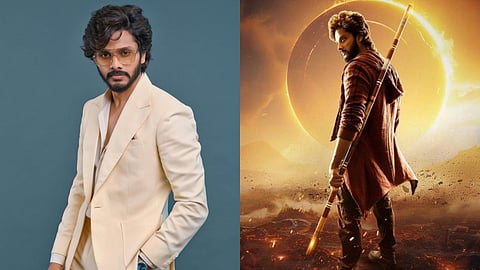Teja Sajja: Whenever people see great CGI, they immediately assume it’s AI
Sometimes, it’s the least-anticipated films that strike gold. Last year, Hanu-Man did just that, turning Teja Sajja, who had already appeared in over 20 films as a child actor, into a breakout lead star. With the bar now raised, expectations are high for his return to the Ramayana-inspired universe in Mirai. Ironically, this anticipation has also brought criticism, with sections of the audience dismissing the trailer’s action sequences as AI-generated. Teja, however, is quick to set the record straight. “In today’s time, it’s sad that whenever people see great CGI, they immediately assume it’s AI. We worked incredibly hard on this film—there’s a train action sequence I trained for over 10 days, and we even shot it on a live location in Sri Lanka. Because it looks so natural, some think it’s AI or computer-generated, but it isn’t. I can’t keep justifying this to everyone, which is why I’ve kept a detailed VFX breakdown and making-of video that I’ll release,” he says, adding, “With such a huge budget and star cast, we are not here to take shortcuts—we’ve put in genuine effort.”
In this conversation, Teja Sajja talks about dealing with monotony when it comes to religion-oriented stories, why he doesn’t want to be called a pan-Indian actor, and more.
Excerpts:
Both Hanu-Man and Mirai are stories inspired by the Ramayana. How do you perceive this Ramayana connection in your filmography?
I believe it is just God’s doing; everything that comes my way is an outcome of the Universe. Personally, I am deeply drawn to our Itihasas. Action-adventure is a thrilling genre that we don’t see often, so if we can merge that with our rooted stories, why not?
What does the word 'Mirai' mean? Is Super Yodha a replacement for a superhero?
It means future, a hope for what lies ahead. It’s a fantasy word we have coined for the weapon, though in the film, it carries another meaning that you’ll understand once you watch it. A superhero is someone who has powers within themselves, but Super Yodha is different. He discovers his dharma and, through that realisation, becomes a Yodha in his own right. He is not just a fighter but also a protector.
How do you deal with the monotony of doing two religion- and culture-based films back-to-back?
Hanu-Man is a deeply rooted cultural film set against the backdrop of a village called Anjanadri. This story, on the other hand, travels across countries and carries an eastern touch, which gives the film a unique look and feel. Along with merging elements of our Indian Itihasas into the narrative, the story is predominantly centred around the myths of Ashoka’s nine unknown scriptures. something we have heard about since childhood.
What is Mirai all about?
What if in today’s world, Ashoka's nine scriptures were being seized by an evil force, and if brought together, they had the power to destroy humanity? The story follows a man connected to the Yodha’s lineage, who has been safeguarding these scriptures for centuries. It is about how he discovers his dharma, how he prevents destruction, and how the answers to saving the world have already been preserved in our Itihasas thousands of years ago. That journey forms the heart of the story. The film has action, adventure, and fantasy woven into it, but at its core, it is about a mother’s dream, her sacrifice, and the lengths a son will go to fulfil her vision. That is the true essence of the story.
While every actor aspires to become a pan-Indian star, you recently said you don’t want to be referred to that way. Why?
I would be very happy to be called an Indian actor—that’s what I want to be known as. While I make films that resonate across languages, I’m not focused on becoming a ‘pan-India’ actor. Today, we talk about pan-India films and actors, but this has been happening long before the term existed. Classics like Arunachalam, Narsimha, Anniyan, and Ghajini were released across multiple languages. We all loved those films and embraced the stars like they were our own, quoting their dialogues proudly.
Is it tricky to work with religious texts in films? What steps do you take to avoid hurting sentiments?
It isn’t that tricky because we follow the Valmiki Ramayan, consult scholars, and ensure authenticity. We intend to bring out the moral highs already present in the Ramayana and Mahabharata. These texts hold answers for every aspect of life, success, failure, and love, often in the form of simple one-liners, like life lessons in their purest form.
Sadly, they are not part of our school curriculum, so through cinema we now have the chance to present them in a way that feels exciting and relatable to younger audiences. Parents have even told me their small children quote dialogues from Hanu-Man and speak of good morals, which is the greatest reward for me.
We are not making an educational film but a proper commercial entertainer with action and emotion, where beneath it all runs a simple message: when you stand for what is right, nature and God will stand with you. If that inspires even a few children, it’s a meaningful difference.
What is your equation with director Prasanth Varma?
I first met him in 2014 during an audition. He was trying to make his first film, and so was I. Director Shashi introduced me to Prasanth, and we discussed a couple of stories, though that film never happened due to producer issues. But from then on, we became good friends. For five to six years, we were co-struggling to break into the industry, constantly exchanging ideas. Our ideologies about cinema, the kind of stories we want to tell, and the effort we put into filmmaking are quite similar—that’s what connected us deeply.
Even before the release of Mirai, you had already signed another film with the producers, People Media Factory. Tell us a little about the film.
I had earlier worked on Oh! Baby with People Media Factory, though I wasn’t the main lead. Mirai is my second film, and through it, I’ve built a great relationship with Vishwa sir. For people who don’t know, he is involved in many other businesses, and cinema is purely his passion. Even though he is producing multiple big films, including ones with Prabhas sir and Sesh garu, he puts the same effort into Mirai and is always just a phone call away. That kind of passion is what I want to be associated with. It has been a wonderful experience working with him and People Media Factory, and I hope to do many more projects together.
As for the upcoming comic film, we are working on something that will connect with audiences across the nation. This time, it will be an out-and-out fun entertainer with a fresh appeal for viewers.
Is Mirai a standalone film, or will it have sequels?
If we create a franchise, I would be the happiest. But it all depends upon the success of this film. If it happens, I’d be the only Telugu actor with three sequels ready, of course, after Prabhas sir.
Going forward, will Teja Sajja’s film choices continue in the path of Hanu-Man and Mirai?
With every film, I’m not always sure where it will take me, but my priorities are clear. First, to entertain the audience. Second, to make clean films. And third, to create stories relevant to all age groups. I want my films to be something that the whole family can come and enjoy together.


